Before we talk about the device you’ll be recording onto, there are a few bits of kit you are always going to need:
Music Career Finder
Survey Start
Mobile Recording Studio: Making music on the go
- Everything you need to know about portable music production.
- Grab a mic, stand, headphones, cables and snacks.
- Consider a groovebox or an iPad with some decent apps.
- Laptops can be great with the right audio interface.
- Lots of good hardware recorders around these days which will take the stress out of having to deal with computers
- Introduction
- Basic Field Recording Kit
- A Microphone
- A Microphone Stand
- Headphones
- Cables
- Snacks
- All-in-one Music Making Machines
- Phones
- iPads
- Laptops
- Hardware Recorders
- Which Way Should You Go?
What's the best piece of gear to take with you so that you never miss a beat? Let's get into it.
You are not always in the studio when inspiration strikes. Sometimes that tune in your head reveals itself at the most inopportune moments. So, if you don’t want to risk that gem being lost before it can enhance the life of humans everywhere then you need some way of capturing your ideas outside the studio. Well, it’s never been easier to make music on the go.
There are all sorts of recorders, music machines, groove boxes, sampling apps, devices and gizmos that you can turn on and sing into, play into or tap out your vibes. From sample-based looping apps to full-on playing your soul out on a bus with you and a chorus of people just trying to go about their day. You can record in the park, you can capture notes on the train, you can be wondering the earth with 20 minutes of battery life and put down some beats.
If you want to be prepared then there are plenty of things you can do to give yourself the best chance of putting down your musical thoughts. If you already carry a bag then here are a few things that you can drop in there that will make it easy for you to record sudden inspiration. What’s important is that you are ready for your next adventure in creativity.
Basic Field Recording Kit
A Microphone
Microphones are vital for sticking in front of the sound you want to record. These don’t have to be complicated or expensive. The most common dynamic microphone is the Shure SM58. It’s your standard handheld vocal mic but it’s good for everything. (But any similar microphone is a good starting point.)
If you want something better, then look into condenser microphones — these are bigger, chunkier and the kind you see in vocal booths. They are far more sensitive than condenser microphones which can be great in the home music studio. However, it can be a problem when going mobile because they will pick up a lot of background sound, passing cars, barking dogs and everything else happening in your recording space.
When recording on the move you are not going to have a very controlled environment in terms of noise and so that should always be a consideration.
There are also plenty of music devices that have built-in microphones. These can work well but they are not going to be as good quality as a regular mic. You have to weigh that up with the convenience of not having to being something else along.
A Microphone Stand
Why do you need a stand? Because otherwise, the microphone will fall over. You don’t need to carry a full height stand but a little desktop stand would keep the mic in the air and directed towards what you want to record. This depends on what you’re trying to do and may be too cumbersome.
Headphones
A mobile situation would often frown at speakers and amplification and they are very heavy to carry. Headphones solve this problem and let you be as loud as you want without disturbing the wildlife. Take two pairs if you are working with someone so you can immerse yourselves in the experience.
Cables
Don’t forget any cables you need to connect things together. Bring spares if you can.
Snacks
Self-explanatory.
All-in-one Music Making Machines
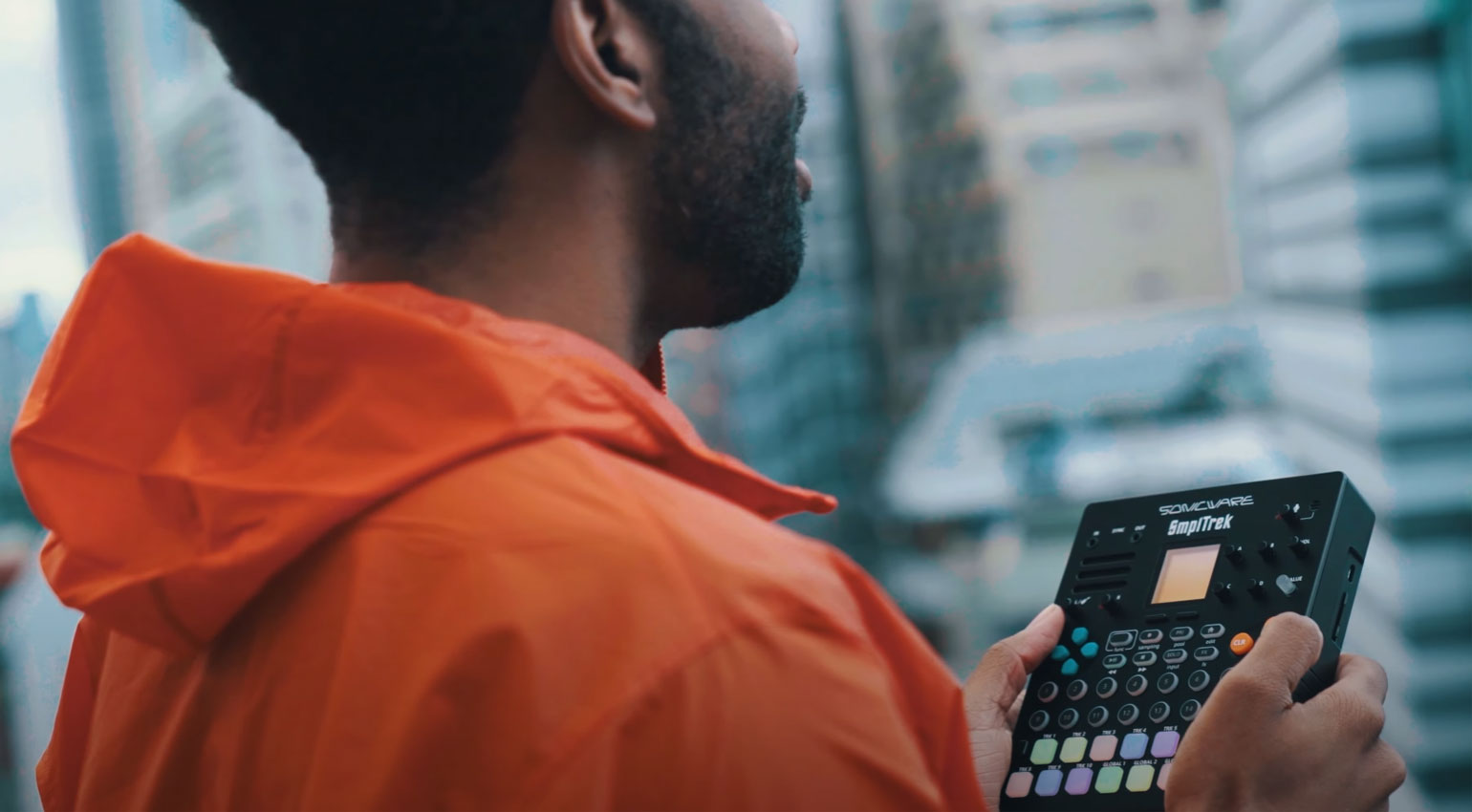
The Groovebox has been around for decades, letting you bash out tracks in a single device. New machines have evolved that have better batteries plus sampling or recording abilities that turn them into very portable mobile recording studios.
A good example would be the SmplTrek from Sonicware. While its main function is as a groovebox for building beats and melodic patterns you can also record vocal and live instrument tracks alongside. You can use the built-in microphone or plug a proper one in the back. Another would be the Polyend Tracker Mini. It’s packed full of synths and samples, it’s super portable and you can sample directly in.
You can build whole albums on these boxes without ever having to be in a studio or look at a computer. If your focus is live recording, or jamming with other musicians or bands then a hardware recorder would be a better bet. But for making music on the go, these standalone workstations are awesome.
Hey, what do you think about trying our new Music Career HelperMusic Career Helper really quick? It’s totally free and could help get your career moving fast! Give it a try. It’s totally free and you have nothing to lose.
Phones
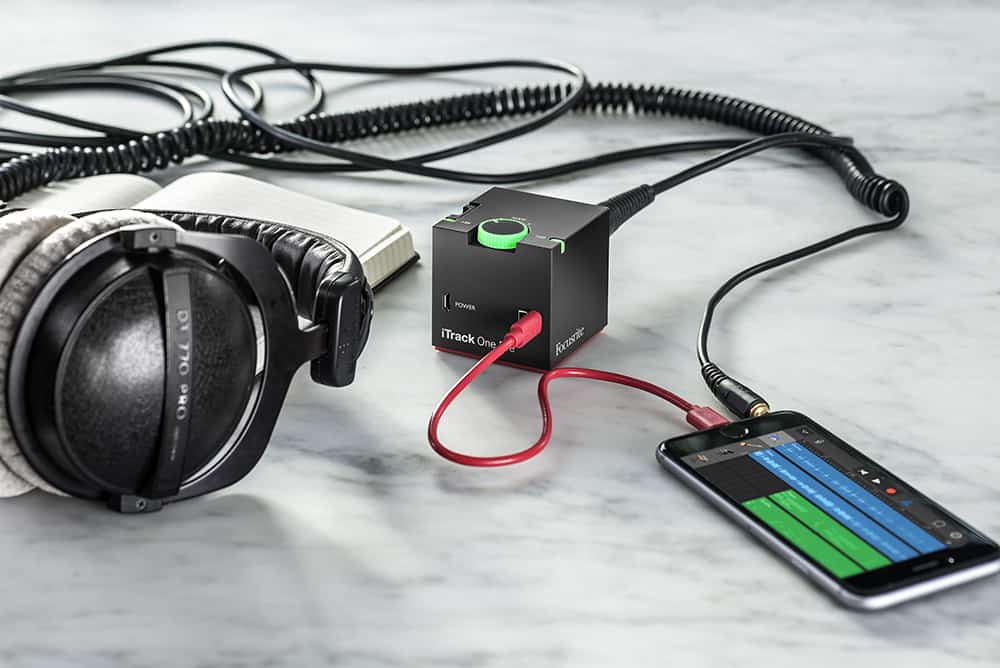
We all have a recording studio in our pockets. When we’re not scanning social media to brighten up our dull lives we can also use them for recording sound. Everything from capturing ideas and thoughts on the bus to recording jam sessions and mixing music can be done on these handheld communication devices. (We did an article on the best DAWs for iOS very recently.)
These provide an environment for multi-track recording, editing, and mixing. You can get away with simply plonking the phone in the middle of your recording space and recording with the inbuilt microphone but it would be better done with some better accompanying hardware.
A small audio interface and a vocal microphone would massively improve the quality of your recordings. It would also lead to the potential of recording instruments separately onto separate tracks in the recording app, although, for a phone, that’s a bit of a challenge.
What phones excel at is being supremely available, ready for any impromptu recording. They’re perfect for singing into when you’ve just made up something awesome in your head. If you are attempting to put together some gear to use for something a bit more serious or intentional then it would be good to aim a little higher.
iPads
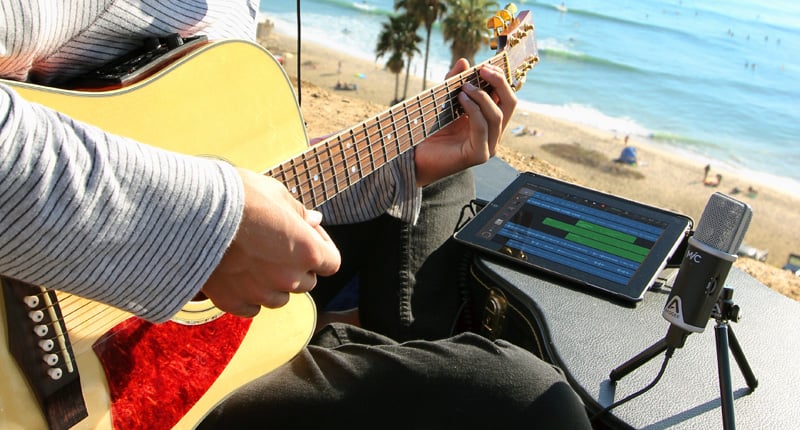
A bump up from a phone would be the musician’s favorite touchable device, the Apple iPad. The boosted processing power and larger screen real estate make for a more usable recording environment. As with the phone, avoid the onboard microphone and get yourself an audio interface to provide some proper recording inputs and playback outputs.
Set up a pair of dynamic microphones in the middle of an acoustic jam session and you’ll have a perfectly serviceable stereo recording directly into your iPad. If you carry some headphones with you then you could also use some of the effects plug-in apps directly on your voice or instruments.
The iPad has the additional advantage of being very easy to manipulate while holding an instrument. Reaching out and hitting a record button on the screen is far easier than trying to use a mouse or trackpad.
One of the downsides of both phone and tablet recording is their lack of disk space. If you are looking to record multiple tracks at high-quality sample rates then it is going to eat through your free GBs in no time at all. Another one people perhaps don’t consider is screen reflection. If mobile recording might take you outside into various environments, then sunshine is going to render your iPad screen unreadable.
But for reasonable mobile recording, indoors, in a small gathering then an iPad and an audio interface are hard to beat.
Laptops
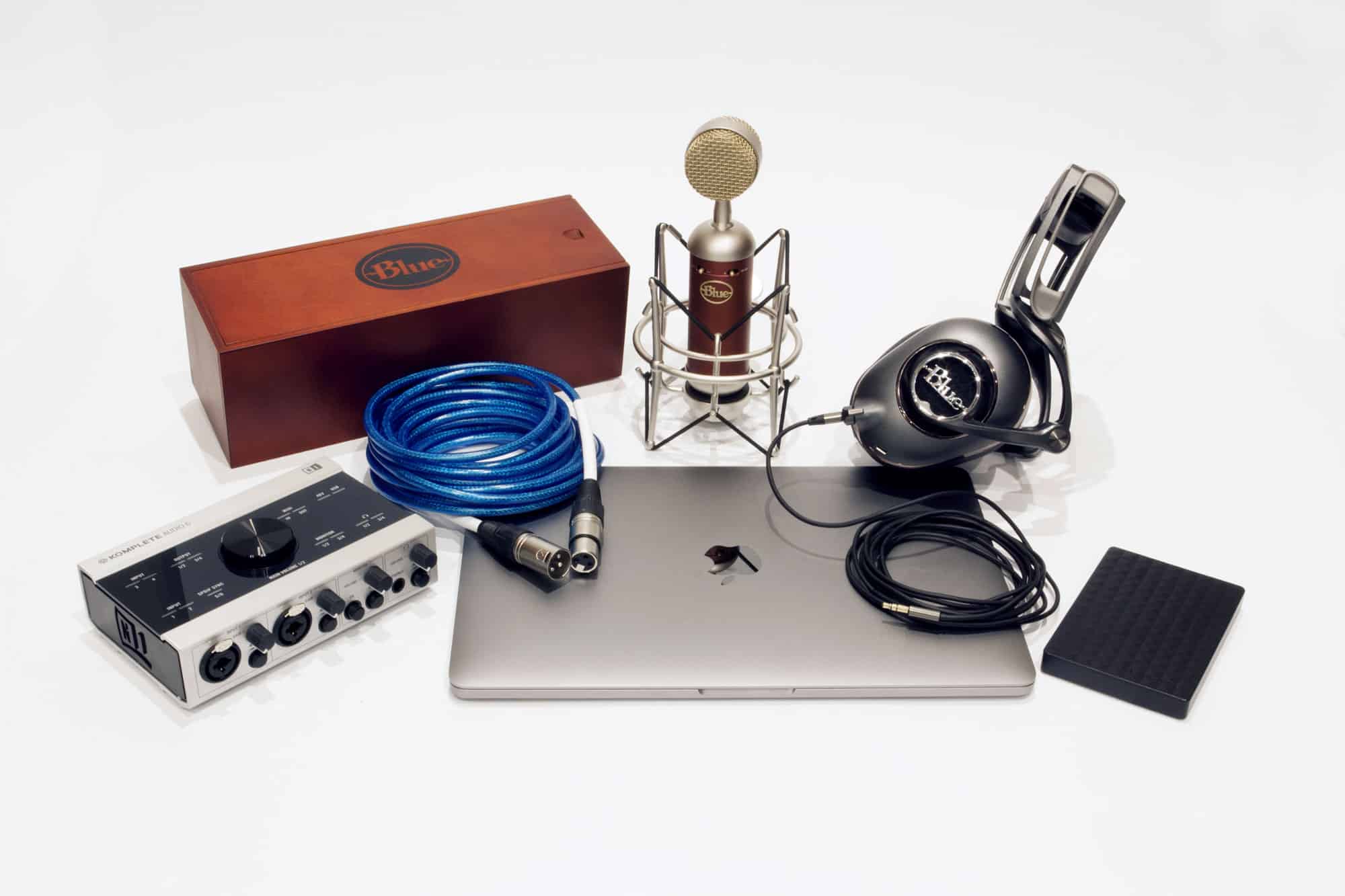
Laptops have become the default mobile recording studio. They are not always as suitable as you’d think. They can be expensive, heavy to lug around, breakable, prone to not working quite right just when you need them to be flawless, and easy to steal. Their popularity for mobile recording is probably down to their availability.
Everyone tends to have a laptop of some sort and so just by adding some software and the audio interface it is a ready-made studio. You can run proper professional software, with plug-ins, virtual instruments, and multiple tracks. They tend to have bags of processing power and much more drive space than tablets. They don’t require extra stands or anything, then just sit on the coffee table or on the floor and off you go.
Laptops are also battery powered and have enough juice to power the odd USB device as well. Tablets and iPads are less able to do that. So, you could be out in the middle of a field with a laptop and a USB audio interface and have a couple of hours of battery-driven recording.
Of course, the Apple MacBook range would make a good choice but do you really want to drag an expensive laptop through fields and into caves or wherever it is you are hoping to record? A vanilla, cheap and cheerful Windows laptop will do just fine. It will run the software, it will run the interface, plug it all on and off you go.
If everything goes according to plan, then it’s a perfectly mobile recording solution. Just be aware both Windows and MacOS can be troublesome at times and always test your gear and update your laptop before you head out.
Hardware Recorders
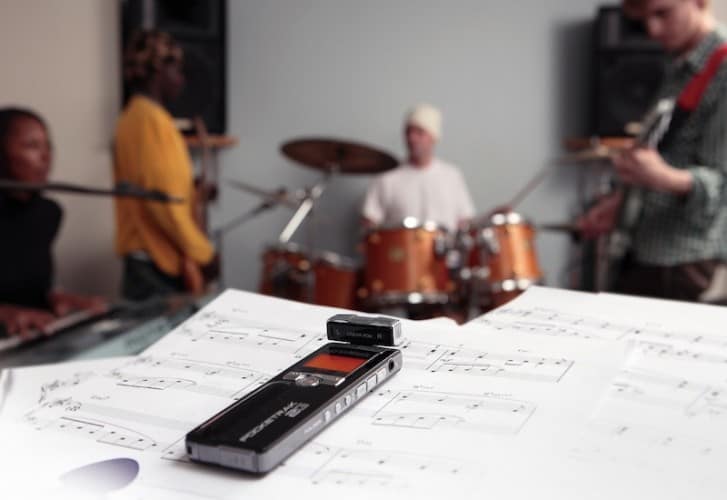
If you want to bypass all the hassle that can come with a laptop or the fragility of a tablet then you might want to consider something a bit more designed for the job. With a hardware recorder, you turn up with a complete multi-track recording studio under your arm. No more messing around with audio interfaces or drivers, screen reflections or fragile devices. Whack it down on the table, plug in your band and hit record!
We also talked about this in our article on building a home studio. Tascam invented the idea of a “Portastudio,” a little 4-track portable recording machine, back in the 1980s. A few years ago, you might have thought computers had made them extinct, but increasingly people are finding a dedicated machine designed for recording is actually much easier, less frustrating and more creative than working with computers.
The genius thing from a portability point of view is you can pick up your entire studio, put it in a bag and take it somewhere else. It will always work, always do the job and never have a fit during an unexpected update. You also can’t get distracted into checking Facebook.
It’s not all fabulous, though. A multi-channel hardware recording, like a Tascam 03SD or a Zoom R8 doesn’t come with any virtual sounds. There are no instruments inside, there are only a few effects that are not expandable. It doesn’t have the endless expansion a computer-based recording solution has, but that’s not always a bad thing.
Battery power is another consideration. The larger Portastudios need main power to run, but some of the smaller ones can run for hours on a pack of AA batteries. The Tascam DP-006 will give you six tracks of recording, runs on batteries and even has two microphones built into the unit. So, you could have your band up on a roof somewhere and get recording.
If it’s just you and you want to be out and about recording, or maybe even sampling environmental sounds then there’s a range of handheld recorders that would do an awesome and dedicated job. You’ll find studio quality recorders, with built-in microphones from Tascam, Zoom, and Sony, amongst others.
Which Way Should You Go?
Consider first what you are trying to achieve. Ask yourself some questions like — how many things am I trying to record? Am I good at troubleshooting computers? Is this a onetime thing or am I going to make a habit of it? Am I making do or do I have a serious budget in mind?
Your phone is a great starting point but I would encourage you to move to the next level as quickly as possible. The quality of your recordings will be improved by added some decent hardware. Microphones and the audio interface will bring a studio quality to your mobile recordings and if you are battery powered then you can always do some mixing on the way home.
The hardware alternative can be rugged, ready for the outside, battery powered and easy to carry. When you get home you can transfer your recordings onto your computer and into your DAW for mixing and processing. For a trouble-free mobile recording studio they are increasingly becoming an attractive option.
With any mobile or portable solution, my advice is to keep it as simple as possible. When in a different environment, with possible time pressures and other people waiting for you to set your gear up, simplicity wins every time and stops you from looking like an idiot.